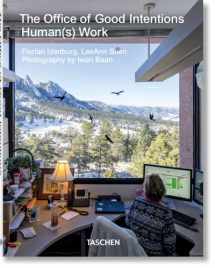
The Office of Good Intentions: Human(s) Work
Book details
Summary
Description
Review
“This book is not an architectural history. It moves with a critical eye through hushed offices and frenzied laboratories, dusty outlaw areas and well-lit influencer stage sets; it rifles through Steve Jobs’s closet and peers into Andy Warhol’s Factory. It is looking for work and finding it everywhere.” ― Florian Idenburg & LeeAnn Suen
“The Office of Good Intentions explores how design and technology have transformed how and where we work through a wide and diverse collection of groundbreaking offices.” ― Metropolis
“…architects Florian Idenburg and LeeAnn Suen take a trip through the history of American office design. As the ‘good intentions’ of the title suggests, they are interested in utopianism – both architectural and tech – and its inevitable corruption.” ― ArtReview
“…dive into some of the world’s most fascinating offices.” ― architecturaldigest.com
“The Office of Good Intentions… examines how the evolution of offices changes us, the people who work in them.” ― The Financial Times
“At a moment when many are reevaluating how offices influence workers’ happiness, productivity and well-being (choose your own order), architects and designers LeeAnn Suen and Florian Idenburg have put together a series of essays and criticism examining five decades of workplace design.” ― Bloomberg.com
Immerse yourself with architects Florian Idenburg and LeeAnn Suen as they journey through a wide-ranging collection of the objects, systems, and buildings that have occupied the American office space since the advent of the internet. Through stories and speculations, Idenburg and Suen expose the relationships between space, work, and people, and explore the intentions that have driven the development of office design for working humans.
In twelve essays, this book examines the spatial typologies and global phenomena that have defined the office in the last half century. Topics include the return of the work club, the rise of the corporate festival, the way of the charismatic guru, the shattering of the time clock, and the design of playgrounds for work. We cycle through Frank O. Gehry’s radical, playful spaces for digital nomads in the advertising world, stagger under the weight of stacks of punch cards, feel the fit of our bodies in the Aeron Chair, answer the phone in Hugh Hefner’s bed, and scroll through Lil Miquela's feed. Photographic essays by Iwan Baan provide a visual post-occupancy report on a range of canonical office projects, such as Marcel Breuer’s IBM campus in Florida and the Ford Foundation’s urban garden in Manhattan. Four intervening catalogs offer collections of experimental workplace products, augural advertisements for office building components, digital office components, and renderings of speculative workplaces; each catalog bridges the reality of the office and how we imagine its alternatives.
This book is a theoretical backdrop for architects as much as it is for businesspeople and employees. With curiosity and skepticism, it looks at the spaces and solutions that have been designed for human work, tracing the transformation from work to occupation, from punch cards to “playbor,” from today’s lived experience to tomorrow’s unpredictable, imagined futures.


We would LOVE it if you could help us and other readers by reviewing the book
Book review



